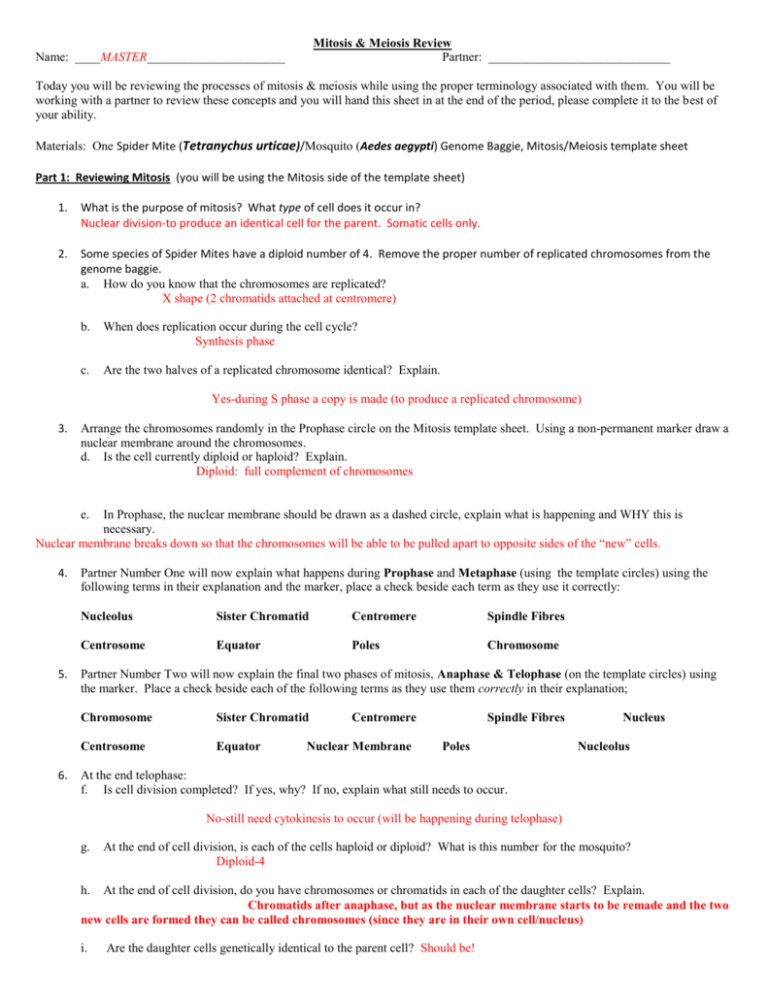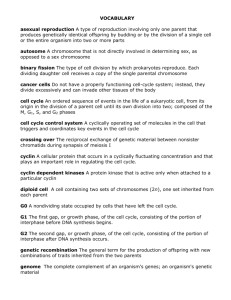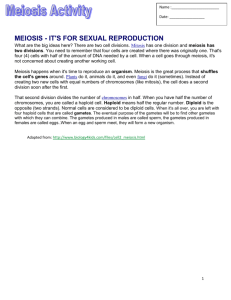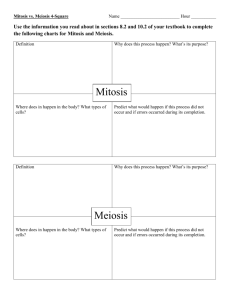Mitosis & Meiosis Review Name
advertisement

Mitosis & Meiosis Review Partner: _____________________________ Name: ____MASTER______________________ Today you will be reviewing the processes of mitosis & meiosis while using the proper terminology associated with them. You will be working with a partner to review these concepts and you will hand this sheet in at the end of the period, please complete it to the best of your ability. Materials: One Spider Mite (Tetranychus urticae)/Mosquito (Aedes aegypti) Genome Baggie, Mitosis/Meiosis template sheet Part 1: Reviewing Mitosis (you will be using the Mitosis side of the template sheet) 1. What is the purpose of mitosis? What type of cell does it occur in? Nuclear division-to produce an identical cell for the parent. Somatic cells only. 2. Some species of Spider Mites have a diploid number of 4. Remove the proper number of replicated chromosomes from the genome baggie. a. How do you know that the chromosomes are replicated? X shape (2 chromatids attached at centromere) b. When does replication occur during the cell cycle? Synthesis phase c. Are the two halves of a replicated chromosome identical? Explain. Yes-during S phase a copy is made (to produce a replicated chromosome) 3. Arrange the chromosomes randomly in the Prophase circle on the Mitosis template sheet. Using a non-permanent marker draw a nuclear membrane around the chromosomes. d. Is the cell currently diploid or haploid? Explain. Diploid: full complement of chromosomes e. In Prophase, the nuclear membrane should be drawn as a dashed circle, explain what is happening and WHY this is necessary. Nuclear membrane breaks down so that the chromosomes will be able to be pulled apart to opposite sides of the “new” cells. 4. 5. 6. Partner Number One will now explain what happens during Prophase and Metaphase (using the template circles) using the following terms in their explanation and the marker, place a check beside each term as they use it correctly: Nucleolus Sister Chromatid Centromere Spindle Fibres Centrosome Equator Poles Chromosome Partner Number Two will now explain the final two phases of mitosis, Anaphase & Telophase (on the template circles) using the marker. Place a check beside each of the following terms as they use them correctly in their explanation; Chromosome Sister Chromatid Centrosome Equator Centromere Nuclear Membrane Spindle Fibres Poles Nucleus Nucleolus At the end telophase: f. Is cell division completed? If yes, why? If no, explain what still needs to occur. No-still need cytokinesis to occur (will be happening during telophase) g. At the end of cell division, is each of the cells haploid or diploid? What is this number for the mosquito? Diploid-4 h. At the end of cell division, do you have chromosomes or chromatids in each of the daughter cells? Explain. Chromatids after anaphase, but as the nuclear membrane starts to be remade and the two new cells are formed they can be called chromosomes (since they are in their own cell/nucleus) i. Are the daughter cells genetically identical to the parent cell? Should be! Part 2: Reviewing Meiosis (you will be using the Meiosis side of the template sheet) 1. What is the purpose of meiosis? What type of cell does it occur in? Nuclear division-to make 4 cells that are NOT identical to each other. Occurs in sex cells. 2. Mosquitos have a diploid number of 6. Remove the proper number of replicated chromosomes from the genome baggie. a. How do you know that the chromosomes are replicated? X-shape b. When does replication occur during the cell cycle? c. During Synthesis phase in interphase. Meiosis requires chromosomes to be “partnered” into homologous pairs, what does this mean, identify three ways that helped you decide which chromosomes are homologous pairs? Same banding patterns, same length, same location of centromere d. Are sister chromatids identical to homologous chromosomes? Or are they both? Explain fully. No-sister chromatids are identical to each other. However each pair of a homologous pair came from a different parent. The homologous pairs have the same GENES on them, but will carry variations of the gene (ALLELEs). e. Where does each chromosome of a homologous chromosome pair come from? One from each parent. 3. Meiosis can be divided into 2 parts: Meiosis I & Meiosis II. Arrange the chromosomes randomly in the Prophase I circle on the Meiosis template sheet. f. Is the cell currently diploid or haploid? Explain. 7. Partner Number One will now explain what happens during Meiosis I (on the template circles) using the following terms in their explanation and the marker. Place a check beside each term as they use it correctly: Tetrad Homologous chromosome Haploid Diploid Sister Chromatid Poles Centromere Spindle Fibres Centrosome Equator Chromosome Synapsis Cytokinesis I Replicated chromosome Draw how Metaphase I was arranged (use proper colours) g. Could it have been arranged another way? Show below. Nuclear Membrane Could it have been arranged another way? What is the significance of the various arrangements that you drew above? Law of independent assortment—cells produced will be genetically different from each other, Increases diversity!!! 8. Partner Number Two will now explain Meiosis II (on the template circles) using the marker. Place a check beside each of the following terms as they use them correctly in their explanation; Chromosome Sister Chromatid Centromere Spindle Fibres Nucleus Centrosome Replicated Chromosome Equator Nuclear Membrane Unreplicated Chromosome Poles Haploid Cytokinesis II 9. The end products of Meiosis are egg or sperm, better known as gametes. a. What is the proper name of the process to make sperm? ____spermatogenesis___________________ b. What is the proper name of the process to make eggs? _____oogenesis_________________________ c. How is the actual process of meiosis (as you worked through it with your partner) changed when making eggs? Only one large egg is produced at end d. What are the characteristics of the final product in egg production? Large, has retained most of the cytoplasm during cytokinesis. e. What are the characteristics of the final product in sperm production? 4 sperm produced, most cytoplasm is removed, flagellum produced 10. If the purpose of Meiosis is to produce haploid cells and at the end of Meiosis I the cell is already haploid, why does a cell need to go through Meiosis II? M I-they are still replicated, end of M II they are unreplicated. 11. Which part of meiosis is most similar to mitosis? Explain using proper terminology. Meiosis II-chromosomes line up on equator during Metaphase II (vs. homologous chromosomes lining up in Metaphase I), during anaphase II chromosomes are pulled apart at their centromere to move to opposite poles. 12. The final product(s) of meiosis are different from the original parent cell. a. Identify & explain two places where genetic diversity occurs during meiosis. Prophase I: crossing over Metaphase I: randomly aligning homologous pairs at the equator 13. Compare and contrast the processes of mitosis and meiosis using the T-chart below. Mitosis Meiosis See your notes from previous day. 14. Return your Genome baggie & template sheet to your teacher, and pick up a “Genetic Terms” baggie. It is time to review some of the new vocabulary that you have been introduced to since the beginning of this unit. Empty the contents of the baggie onto your desk, turn all terms upside down and mix them up thoroughly! Take turns choosing a genetic term from the pile and have your partner define/explain it in their own words. If you agree that they have defined it properly, they get a point, if you have to correct them, you get the point, if you both have to look up the definition in your textbook-neither of you get the point and the term gets reshuffled back into the pile on the desk! Prizes will be awarded at the end of the period, so keep score!








